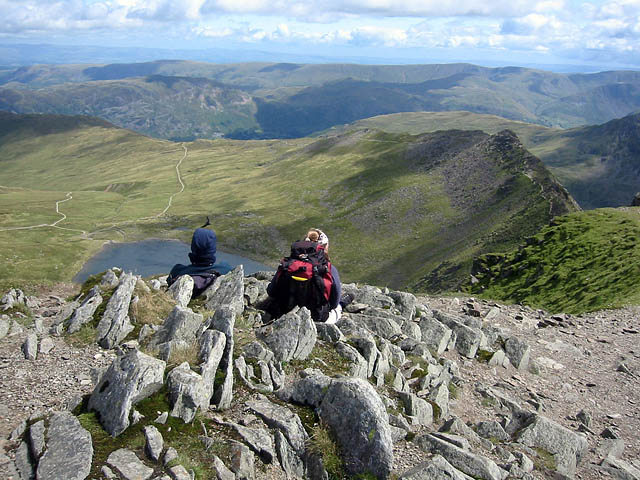 Fellwalking in the Lake District is a dangerous pursuit, according to figures released this week.
Fellwalking in the Lake District is a dangerous pursuit, according to figures released this week.
Right: walkers look down on Striding Edge from the summit of Helvellyn
Rescue organisations in the district dealt with a record 28 deaths last year, the highest number for 17 years – and of the 28 fatalities, 18 were walkers, with a further 144 injured while walking. One fell runner died and one person perished while scrambling.
The Lake District Search and Mountain Rescue Association, which represents the 13 teams operating in the area, has released its annual round-up of the rescues its members have been carried out. Eight of the deaths dealt with were not mountain accidents.
Contrary to popular perception, climbing in the Lakes is not as hazardous a hobby as walking, with only one rock-climbing injury and one ice-climbing casualty, though this may reflect the growing popularity of indoor wall climbing and the disappearance of much of the good ice-climbing conditions as winters get warmer.
In 1991, for instance, six people died rock-climbing and 37 were injured while climbing on snow and rock. Not surprisingly, given the lack of sustained snowfall in the Lakes, there has not been a recorded skiing accident since 1995. However, 2006 did see one avalanche call-out.
Mountain Rescue Teams (MRTs) in the Lake District were mobilised to 396 incidents, just one more than the previous year; 493 casualties and injuries were recorded. 24,335 hours were put in by team members – all of whom are unpaid volunteers – on call-outs, a massive 48 per cent increase on 2005. RAF and Royal Navy helicopters assisted in 93 instances.
John Dempster, chairman of the association, said the increase in fatalities probably reflected the area’s increasing popularity. But he also warned that fellwalkers were often ill-equipped and not properly able to navigate in difficult conditions.
Mr Dempster said walkers were increasingly using mobile phones for help when they should be looking to get themselves out of trouble. He said: “There has been growing problem with people taking the easy option when they feel that they are lost.
“Rather than trying to use a map and compass to find their location, which would probably have happened in the past, they're using mobile phones to call for help.
“Quite often when we find them they're just on the path but uncertain where they are.”
Fellwalkers getting lost is the biggest single cause of call-outs, slips and falls being the next most common reason. Unsurprisingly, the ankle is top of the league for injuries, with lower leg and knees coming runners up, if you’ll pardon the awful pun. 15 injuries last year involved spinal damage and 17 to the head.
Heart attacks are another common problem on the fells, though fractures are the injury most likely to be encountered.
MRTs also help with urban searches, water searches and incidents such as the Grayrigg train crash. Teams also helped during the Morecambe Bay cockling tragedy when 21 migrant workers died on the treacherous sands of the bay.
Donation can be made to the MRTs via the association’s website .
andrew
15 July 2009excellent article, perhaps more people should throw away their sat navs and learn to read maps! Keep up the good work.